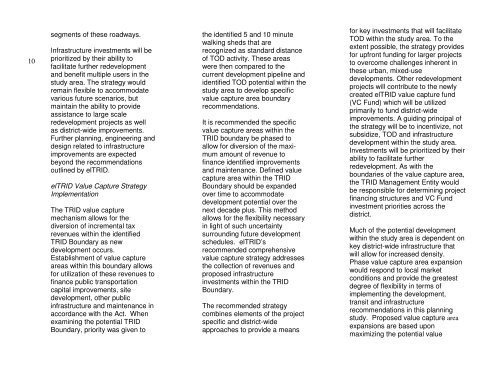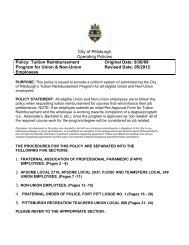east liberty station: realizing the potential - City of Pittsburgh
east liberty station: realizing the potential - City of Pittsburgh
east liberty station: realizing the potential - City of Pittsburgh
Create successful ePaper yourself
Turn your PDF publications into a flip-book with our unique Google optimized e-Paper software.
10<br />
segments <strong>of</strong> <strong>the</strong>se roadways.<br />
Infrastructure investments will be<br />
prioritized by <strong>the</strong>ir ability to<br />
facilitate fur<strong>the</strong>r redevelopment<br />
and benefit multiple users in <strong>the</strong><br />
study area. The strategy would<br />
remain flexible to accommodate<br />
various future scenarios, but<br />
maintain <strong>the</strong> ability to provide<br />
assistance to large scale<br />
redevelopment projects as well<br />
as district-wide improvements.<br />
Fur<strong>the</strong>r planning, engineering and<br />
design related to infrastructure<br />
improvements are expected<br />
beyond <strong>the</strong> recommendations<br />
outlined by elTRID.<br />
elTRID Value Capture Strategy<br />
Implementation<br />
The TRID value capture<br />
mechanism allows for <strong>the</strong><br />
diversion <strong>of</strong> incremental tax<br />
revenues within <strong>the</strong> identified<br />
TRID Boundary as new<br />
development occurs.<br />
Establishment <strong>of</strong> value capture<br />
areas within this boundary allows<br />
for utilization <strong>of</strong> <strong>the</strong>se revenues to<br />
finance public transportation<br />
capital improvements, site<br />
development, o<strong>the</strong>r public<br />
infrastructure and maintenance in<br />
accordance with <strong>the</strong> Act. When<br />
examining <strong>the</strong> <strong>potential</strong> TRID<br />
Boundary, priority was given to<br />
<strong>the</strong> identified 5 and 10 minute<br />
walking sheds that are<br />
recognized as standard distance<br />
<strong>of</strong> TOD activity. These areas<br />
were <strong>the</strong>n compared to <strong>the</strong><br />
current development pipeline and<br />
identified TOD <strong>potential</strong> within <strong>the</strong><br />
study area to develop specific<br />
value capture area boundary<br />
recommendations.<br />
It is recommended <strong>the</strong> specific<br />
value capture areas within <strong>the</strong><br />
TRID boundary be phased to<br />
allow for diversion <strong>of</strong> <strong>the</strong> maximum<br />
amount <strong>of</strong> revenue to<br />
finance identified improvements<br />
and maintenance. Defined value<br />
capture area within <strong>the</strong> TRID<br />
Boundary should be expanded<br />
over time to accommodate<br />
development <strong>potential</strong> over <strong>the</strong><br />
next decade plus. This method<br />
allows for <strong>the</strong> flexibility necessary<br />
in light <strong>of</strong> such uncertainty<br />
surrounding future development<br />
schedules. elTRID’s<br />
recommended comprehensive<br />
value capture strategy addresses<br />
<strong>the</strong> collection <strong>of</strong> revenues and<br />
proposed infrastructure<br />
investments within <strong>the</strong> TRID<br />
Boundary.<br />
The recommended strategy<br />
combines elements <strong>of</strong> <strong>the</strong> project<br />
specific and district-wide<br />
approaches to provide a means<br />
for key investments that will facilitate<br />
TOD within <strong>the</strong> study area. To <strong>the</strong><br />
extent possible, <strong>the</strong> strategy provides<br />
for upfront funding for larger projects<br />
to overcome challenges inherent in<br />
<strong>the</strong>se urban, mixed-use<br />
developments. O<strong>the</strong>r redevelopment<br />
projects will contribute to <strong>the</strong> newly<br />
created elTRID value capture fund<br />
(VC Fund) which will be utilized<br />
primarily to fund district-wide<br />
improvements. A guiding principal <strong>of</strong><br />
<strong>the</strong> strategy will be to incentivize, not<br />
subsidize, TOD and infrastructure<br />
development within <strong>the</strong> study area.<br />
Investments will be prioritized by <strong>the</strong>ir<br />
ability to facilitate fur<strong>the</strong>r<br />
redevelopment. As with <strong>the</strong><br />
boundaries <strong>of</strong> <strong>the</strong> value capture area,<br />
<strong>the</strong> TRID Management Entity would<br />
be responsible for determining project<br />
financing structures and VC Fund<br />
investment priorities across <strong>the</strong><br />
district.<br />
Much <strong>of</strong> <strong>the</strong> <strong>potential</strong> development<br />
within <strong>the</strong> study area is dependent on<br />
key district-wide infrastructure that<br />
will allow for increased density.<br />
Phase value capture area expansion<br />
would respond to local market<br />
conditions and provide <strong>the</strong> greatest<br />
degree <strong>of</strong> flexibility in terms <strong>of</strong><br />
implementing <strong>the</strong> development,<br />
transit and infrastructure<br />
recommendations in this planning<br />
study. Proposed value capture area<br />
expansions are based upon<br />
maximizing <strong>the</strong> <strong>potential</strong> value
















